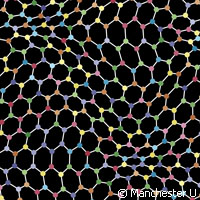
What can you get when you combine graphene with metallic nanostructures? Improved harvesting light by graphene, which could potentially lead to super-fast Internet, a new UK study shows.
A team of scientists, which includes Nobel Prize winners Professors Andre Geim and Kostya Novoselov, from the Universities of Manchester and Cambridge in the United Kingdom has pieced together the puzzle that could enhance the characteristics of graphene devices for use as photodetectors in future high-speed optical communications.
Combining graphene with metallic nanostructures triggered a huge enhancement in harvesting light by graphene without losing any speed. Not only would this help accelerate the Internet but other communications would get a boost as well. A key characteristic of graphene devices is that they are very fast, surpassing current Internet cables.
The scientists placed two closely spaced metallic wires on top of graphene and shone light on this structure. Doing this helped generate electric power. According to them, this simple device presents an elementary solar cell.
The biggest challenge for the researchers was dealing with low efficiency. Graphene is the thinnest material across the globe, absorbing just 3% of light. So the remaining light passes through without contributing to electrical power. To get the results they wanted, the team combined graphene with tiny metallic structures arranged on top of graphene.
Plasmonic nanostructures have helped advance the optical electric field felt by graphene and have concentrated light within the carbon layer, which has a thickness of one atom.
‘Graphene seems a natural companion for plasmonics,’ says Manchester’s Dr Alexander Grigorenko. ‘We expected that plasmonic nanostructures could improve the efficiency of graphene-based devices but it has come as a pleasant surprise that the improvements can be so dramatic.’
For his part, Professor Novoselov, also from the University of Manchester, says: ‘The technology of graphene production matures day-by-day, which has an immediate impact both on the type of exciting physics which we find in this material, and on the feasibility and the range of possible applications. Many leading electronics companies consider graphene for the next generation of devices. This work certainly boosts graphene’s chances even further.’
Commenting on the findings,Cambridge’s Professor Andrea Ferrari says: ‘So far, the main focus of graphene research has been on fundamental physics and electronic devices. These results show its great potential in the fields of photonics and optoelectronics, where the combination of its unique optical and electronic properties with plasmonic nanostructures, can be fully exploited, even in the absence of a bandgap, in a variety of useful devices, such as solar cells and photodetectors.’



